|
The
following is the first in a series of in-depth articles on the
firearms of the Old West, their history and lore, and the
remarkable men and women who carried them... excerpted from
Jesse’s full-color book Old Guns & Whispering Ghosts
(www.oldgunsbook.com).
  
Whether for daily
“dressed-down” carry or as a “backup” piece in case
one’s main arm failed, pocket guns were a common and defining
element of the Old West. Rifles
have always been more powerful, more accurate, and more
effective at long ranges, and no firearm is more deadly than a
scattergun. The
main advantage of a hand-held firearm, then as now, was its
relative light weight and convenient size, making it more likely
to be actually carried when the rare occasion arises to put it
to use. As well as
how much easier it was to hide.
Concealability has
been a factor in gun choice for as long as European Monarchies
and U.S. city councils have sought to restrict them.
Gun control laws that were long a reality in the American
East, soon spread to the quickly settling West.
No less a notorious shootist than Wild Bill Hickock was a
strict enforcer of an antigun ordinance in his days as Sheriff,
clubbing anyone senseless that didn’t immediately turn his in
upon arrival in town. The
number one option for men was a leather lined pocket with a
medium to full sized arm, thus the term “pocket pistols.”
But specially scaled down models made it possible to
sneak some degree of protection even in Summer dress.
While lacking the knock down capabilities of their bigger
brothers, these “belly guns” made the difference whenever a
partying miner found himself suddenly needing to protect his
hard earned gold dust, or a school marm (teacher) needed to
defend her honor in the face of an amorous and aggressive drunk.
Many of the situations calling for active self defense
occur when least expected, and not always in the most obvious
places and situations. At
such times both the Henry hanging inside on the wall or the
shotgun stashed under the buckboard seat are likely well out of
reach. The gun that
counts most, then, is often the one that’s carried every
day– on foot and on horseback, at work and at play.
For scantily clad
saloon girls and bare armed faro dealers this would have meant
derringers and other tiny, easily secreted pistols often
referred to as “stingy guns.” Many of these were anemic .22’s, one of the smallest of
which being the miniscule Remington Vest Pocket
“saw-handled” single shot.
Early multi-round .22 caliber derringers include the two
round American Arms Wheeler model, the five-shot double-action
Remington-Elliot’s “ring-trigger” design, the extremely
rare Reid “My Friend” with its revolving cylinder and no
barrel, the Bacon “pepperbox” and Sharps models with four
fixed barrels and a rotating firing pin.
Only slightly larger were the host of single-shot breech
loading derringers chambered for the moderately more powerful
.41 rimfire cartridge. These
generally featured barrels that either pivoted downward or
rotated to the side for loading.
The acknowledged progenitor of this type is the Daniel
Moore, patented in 1861. Others
followed, including Colt’s National, #1
and #2 models, the Wesson, the Charles Ballard, the John
Marlin “Victor” and “XL’S,” the Stevens, the Allen,
and the so-called “Southerners” made by Brown Manufacturing
Co. and Merrimac Arms. Loaded
with a 130 grain conical bullet and stuffed with 13 grains of
black powder, it could barely achieve 400 feet per second
velocity out of the typical three inch long barrel.
Even Henry
Deringer’s original percussion pocket pistol had considerably
more penetration and knockdown power than the .30, .32 and .41
rimfire breech loaders that followed (now collectively thought
of as “derringers”– a misspelling of Henry Jr.’s name). These lilliputians nonetheless contributed to an owner’s
sense of security, and no doubt their brandishing alone was
enough to calm escalating disputes.
After all, no one wants to be shot, even by an
underpowered round. And
the terror of being wounded was justifiably all the greater in
the West of the 19th and early 20th Centuries, with it’s
paucity of doctors, questionable hygiene, and failure to fully
appreciate the importance of sterilization when it came to
dressings, hands and medical tools.
Many deaths by gunshot were the result of subsequent
infection, rather than the size or location of the wound.
A .41 RF that barely penetrated would still carry into
the body minute pieces of germ laden material from the clothes
one wore, and the spectre of a long painful illness and feverish
death would have made all but the most cavalier debater
reconsider his more provocative arguments.
According to Capt.
Joseph Bourke one 1880’s Arizona lawman packed as many as ten
small derringers secreted on his person at a time.
Believe that or not, anyone with a soft spot for early
Wild West Show entertainers, Western pulp fiction, movies or
television serials has some idea of how these pip-squeak backups
might save the day. In his sunset years Buffalo Bill Cody often relied on an
ivory stocked, nickel plated Remington over and under .41
derringer with amateurish engraving.
The character Paladin on “Have Gun Will Travel”
packed the same under the skirt of his revolver holster.
Special agent James in “The Wild Wild West” had a
similar Remington rigged up on some kind of mechanical device
inside his shirt cuff, and he could cause it to spring into his
hand on command. They
make it easy to imagine some hero, with his hands in the air and
an empty holster on his hip, suddenly turning the tables with a
firearm the size of single Colt Peacemaker grip.
Fiction was matched by
reality in at least one dramatic event, a surprise shootout at a
peace conference between Modoc war chief Captain Jack and U.S.
General Canby. The Indian warrior shocked everyone by suddenly pulling out a
hidden revolver and shooting the General in the head. When another Indian, Schonchin pulled out his own weapon,
onetime Indian agent A. B. Meacham wounded him and brought him
to the ground with a shirt pocket .41.
There have also been
some fascinating arms created solely for the purpose of
disguised carry. Some
of the most fascinating are revolvers disguised as handbags or
“wallets.” Imported
from Europe or hand made by tinkerers in the good ol’ U.S.A.,
they were made of cloth covered metal, and could be set
off by a hidden trigger. No doubt the women who bought them liked to imagine the
surprise of a robber– who after asking a woman for her money
bag, gets either a bullet in the belly or at least the scare of
a life! Other
clever oddities included single shot pistols that could double
as “brass knuckles” once fired.... plus revolvers with built
in folding knives, and even pocket knives that “go boom.”
Cane or walking-stick
guns replaced walking-cane swords the backup of choice for 19th
Century English gentlemen.
The earliest were muzzle loaders, later models usually
fired a single rimfire cartridge, and eventually rounds as
powerful as the .410 shot shell found there way into these
orthopedic aids and symbols of taste and class.
Particularly interesting are the British made air-canes
marketed at the turn of the century through various New York
distributors. The
reservoirs were refilled using an attachable stirrup pump, took
a long time to charge, and fired what was usually a .32 caliber
ball with far more force than you might think.
Every cane type included a muzzle cap to keep dirt and
debris out of the barrel, and the results could be dramatic if
someone ever forgot to remove it before firing.
A few canes
undoubtedly found their way West, especially following
Remington’s introduction an American made model.
Available in either .22 or .32 RF, they could be
purchased with either plain, ivory, carved claw-and-ball or
dog’s-head handles.
Anyone with a real
likelihood of armed defense was unlikely to choose a derringer
anymore than a walking stick gun.
For this purpose most people wanted multiple shots
without reloading, with the result being a burgeoning new market
in medium powered, pocket-sized revolvers. The highest quality examples of this genre were produced by
Colt, Remington, Rupertus, Hopkins & Allen and Forehand
& Wadsworth. At
one time or other Pat Garrett owned a .41 RF F&W “Swamp
Angel” (serial number #4318) featuring a gold plated cylinder
and a backstrap engraved with his name, as well as a .38 S&W
CF caliber Merwin & Hulbert Pocket Army revolver with a
unique folding hammer presented him by the favored citizens of
Uvalde, New Mexico. Both featured ivory stocks and rudimentary “New York”
style scroll engraving.
All such arms sported
similar profiles to the early S&W tip-ups: “sheath” or
“spur” triggers (sans trigger guard) with three to five inch
barrels and generally rounded, “bird’s head” grip frames.
Around 1874 Remington’s added their “two cents”
worth with their Smoot patent line.
The .30, .32, and .38 rimfire Remingtons featured simple
ejector rods, while their .41 RF variant did not.
Colt continued its
tradition of pocket arms with its 1870 release of their
“Cloverleaf” (deep fluted) cylinder “House Pistol,” a
four shot revolver in .41 RF, one of which is provenanced to
Inspector of Railroads and onetime Confederate General William
Hardeman. That same
year they began flooding the market with the itsy-bitsy .22
“open top,” churning out some 110,000 before finally giving
it up in 1877. Both
were essentially made obsolete in 1874 with the introduction of
five Colt’s “New Line” series in five different graduated
frame sizes. Served up in rimfire .22 and .30 rimfire, plus .32, .38 and
.41 centerfire. The
last of this configuration was their New Police .38 CF.
Like the cleverly named “House” pistol, its “cop
and thug” motif grips appealed to the need for convenient
personal and home security. The
New Lines often served as back up guns, paired with Colt’s
ubiquitous large bore Peacemaker.
They were effectively phased out by the mid 1880’s
under market pressure from the scads of cheap imitations such as
the two-dollar “suicide special” removed from Hickock
murderer Jack McCall in 1876.
Their niche in the prestigious Colt lineup remained
unfilled until the 1896 release of the double action New Pocket
model.
Since the day Smith
& Wesson locked up the patents for the bored-through
cylinder (and thus for the repeat shot breech loading handgun),
their various small arms have enjoyed a fervent and faithful
following. Beginning
in 1857 with the introduction of the tip-up
models #1 in .22, the previously discussed #1 1/2 and #2
in .32 rimfire, S&W went on to even greater success with a
much stronger top-break design first introduced in 1870 in their
large frame, large bore Model #3 American.
This was followed in 1876 and 1878 with medium frame
top-breaks in .38 and .32 centerfire.
The .38 S&W CF cartridge was more briskly loaded with
a 16 grain black powder charge, topped by a 145 round nosed
bullet. Smith and
Wesson manufactured and shipped in excess of 130,000 “New
Model” or “Baby Russian” .38’s before finally taking it
off line in 1891. This
medium powered round went on to be one of the most popular
calibers of its time.
In 1892 a posse headed
by Marshal Paden Tolbert surrounded and eventually blew up with
dynamite a recessed log “fort” manned by the framed Cherokee
outlaw Ned Christie. In
a photo taken shortly after the raid, posse members are seen to
have Harrington and Richardson, S&W and Colt New Line pocket
revolvers tucked into their vests and waistbands, along with a
large frame Colt 1878 .44 WCF and a hodgepodge of rifles and
shotguns. Needless
to say, it was the TNT that carried the day, and these
lightweight backups were unlikely used in the fray.
Sheriff William “Billy” Tilghman helped bust up the
Doolin gang and clean up Oklahoma’s infamous “Hell’s Half
Acre,” and his reputation alone was enough to settle most
disputes. But it was a hidden
belly gun in the hands of boozed-up Prohibition Agent (!) that
ended both his life and his career.
Yet another factor in
handgun selection, hideaways or not, has always been rapidity of
fire: how fast one can get off repeat, aimed shots.
The single action revolver (in which the hammer has to be
hand cocked each time) is nearly if not equally quick for the
first round. But
the double action (with the hammer cocked and the cylinder
rotated by a single long pull on the trigger) has a significant
edge when it comes to subsequent aimed shots, and is
considerably quicker to empty into the belly of a close range
assailant.
Smith & Wesson’s
first double action topbreaks hit the shelves in 1880, with over
one thousand of its Third models having been sold to the
American Express Co. for the protection of its agents and
guards. These
remained their primary hideaways until the 1899 advent of their
now signature “hand ejector” (swing-out cylinder) designs,
currently exemplified by the “Chief’s Special” Model 36.
Other substantial .38
CF caliber double action topbreaks were made in the latter part
of the 19th Century by manufacturers
Harrington & Richardson, Hopkins & Allen and Iver
Johnson Bicycle Works with their characteristic gutta percha
grip panels– featuring the face of an owl and ornamental
filigree. Long
barrels could be had on most, but for purposes of defense and
concealment the preferred length for this caliber remained
something between three and five inches.
They’re not hideaways, after all, if they leave an
outline or bulge that’s easily seen.
Favorite places for stashing small arms include not only
pockets but boot tops, shoulder holsters and suspender rigs for
those on the move. And
under pillows, in bedstand drawers, and inside the cash
registers of folks at home and at work.
A purse was the most
common way for a woman to pack a sidearm, and may still be
today. Unfortunately it’s a less than optimum arrangement, given
that it’s the first thing a snatch-thief is likely to grab.
One can only speculate how many times some gal has has
been surprised to find herself relieved of not only her money
and her make-up kit, but also her primary means of defense.
More effective would be an open top belt holster worn
high on the small of the back, or strapped above the knee
underneath a billowing Western skirt.
Small caliber
revolvers were perhaps ideal for daily concealed carry– but
those with no need to hide their armament, and anyone wearing
enough of a coat might pick a larger gun in substantially more
powerful calibers. One
of the smallest pocket canines with real bite was the Webley
& Son Bulldog, an imported five shot, double action revolver
available in .44 Webley caliber– roughly twice as powerful as
the prevailing .38 S&W.
While copied and altered here and abroad, the original
British models came with bird’s-head grip frames, two and a
half inch barrels and unfluted cylinders.
They began showing up in the far West as early as 1873,
and one found its way into the hands of Billy The Kid’s patron
and employer, John Tunstall.
It’s larger bore and spreading popularity was no doubt
a factor in Colt bringing out it’s own medium frame double
action revolvers in 1877 and 1878: the nicknamed “Lightning”
in .38 Long Colt, and the “Thunderer” in .41 Colt caliber.
Awesome knock down
power has its own appeal. Merwin
& Hulbert brought out a bird’s head grip model called the
Pocket Army in both .44 M&W and .44 WCF (.44-40).
With it’s factory shortened three inch plus barrel, it
still weighed a good two pounds, four ounces.... making it a bit
heavy for concealed carry, leather lined pocket or not.
But evidently not too much for the unredeemable Bass
Outlaw, who had an open top version (serial #195) recovered from
his person for waving it around in an El Paso saloon “in a
manner calculated to disturb the inhabitants of said public
place.” Nor for
unsuccessful girl bandit Pearl Heart, who was allegedly carrying
another M&W (serial #645) tucked in her pants belt when
arrested by Sheriff W. Truman in 1899.
Weighty large frame
Colts and Smith & Wessons are often found altered by their
original owners, obviously looking to pack more power in a
somewhat concealable package.
A large number of S&W single action Americans,
surplus Schofields and #3’s on the antique market today have
at one time or other had their tubes reduced to four or five
inches. And sadly
from a collector’s point of view, so have all too many old
Colt SA’s– including the now rare Artillery models.
John Selman paid for the burial of Bass Outlaw with a
confiscated, chopped Colt (serial #42870) specially altered for
fanning by the removal of the trigger assembly and replacement
of the cylinder pin. In
that condition a revolver would be quick to employ, but nearless
worthless beyond ten feet for so.
With its factory
issued tube and trigger, a competent pistolero could hit a
stationary man sixty or more yards away a good percentage of the
time. An 1873
Winchester carbine was reasonably effective out to one hundred
and twenty-five yards, and double that for the same company’s
1894 rifle. As I
write this, military weaponry has “improved” to the extent
that tank gunners and fighter pilots can deliver devastating
payloads of high explosives with pinpoint accuracy at previously
unimaginable distances.... without ever looking up from their
computer screens, or looking into the faces of those they need
to kill. This has resulted in a depersonalization of armed combat, and
increasingly positions our soldiery far enough away from the
enemy to dilute the emotional experience, reducing any
opportunities for empathy or mercy, and making the taking of
life more of a mechanical exercise in obedience than a
deliberate moral decision and an act of passion. Of course even the heavy single-shot “buffalo rifles” of
the 1800’s were capable of consistent hits five times further
than the shooter could positively identify their target.
And if an opponent is further away than the length of a
barroom there’s probably an option for cover or retreat.
While I doubt my namesake Wes Hardin would agree– if
I’m far enough away to avoid an incident, I’d usually just
as soon exit the scene.
It’s true that
President Abraham Lincoln was shot in the head at close range
with a snub nosed percussion derringer.
But John Wilkes Booth aside, pocket guns have seldom been
employed by intentional assailants.
There is therefore considerably less moral ambiguity with
arms primarily designed for self protection and generally
unsuitable for offense. No
one in their right mind would bring a hideaway to initiate a
fight. They’re
more likely to be found in the hands– or still stashed in the
pockets– of those who have been wronged.
As every reader of
GunBlast would agree, self defense is a justifiable and even
healthy response to unprovoked aggression.
Since the primordial beginnings of our kind, we’ve
joined the rest of creation in doing everything we can to
preserve and extend our mortal lives. We are motivated and fueled by the same source that provokes
cells to grow and multiply, rabbits to strike out against a
ravenous snake– or a snake to fight off the hungers of the
giant eagle.... even if another few minutes of survival means a
deadly drop of hundreds of feet!
It is the Spirit-given impulse to struggle again and
again into the light, and to never give up the fight.
No one can be faulted for valuing their own existence
over that of an attacker.
Complacency and capitulation, like obliviousness, are
what make us prey.... not the mere existence of predators.
Truly, personal
survival is an inherent, credible and honorable motivation,
qualifying our most insistent and energetic defense.
But then again, neither is it necessarily the most noble
of all reasons for taking assertive action.
The desire to live is sacred as well as natural, and yet
the protection of our narrowly defined selves isn’t always the
most important thing. For
a person of integrity and compassion there are also people,
homes and beliefs worth risking our lives for.
Once we recognize that our families are integral and
vital extensions of our very beings, protecting them becomes an
act of expanded self defense.
In time we may come to realize the degree to which our
ideals, our friends and communities, the forests, rivers and
land we stand upon are essential elements of what it means to be
human.... and that to protect their expression and wholeness is
to defend what it is to be “us.”
Pocket guns and
hideaways are but one demonstration of insistence and self-love,
determination and daring. Of
grit and gravel, courage and caring!
That something really matters, none need wonder... given
the flashes of life and lightning in our eyes, and the judicious
roar of hidden thunder.
Jesse
L. "Wolf" Hardin
  
Hideouts
is adapted from Hidden Thunder, a chapter in Jesse’s
book Old Guns & Whispering Ghosts: Firearms Of The Old
West 1866-1916.
Click
here to read Boge’s review of this book.
To order a copy
specially signed to you, go to www.oldgunsbook.com.
  
Got something to say about this article? Want to agree (or
disagree) with it? Click the following link to go to the GUNBlast Feedback Page.
|
|
Click pictures for a larger version.
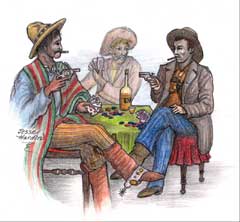
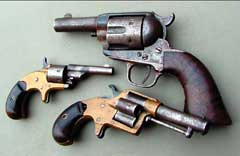
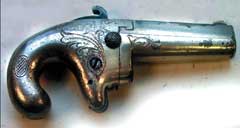
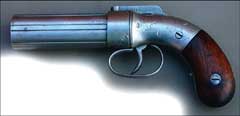

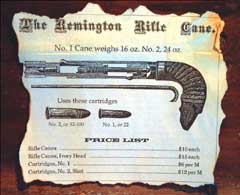

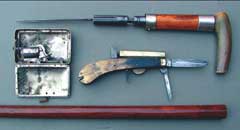
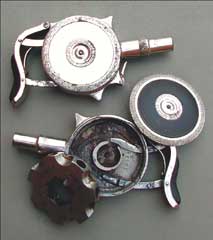
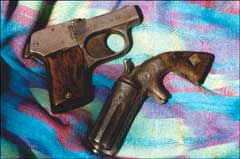
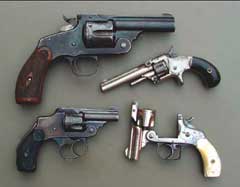
|
![]()